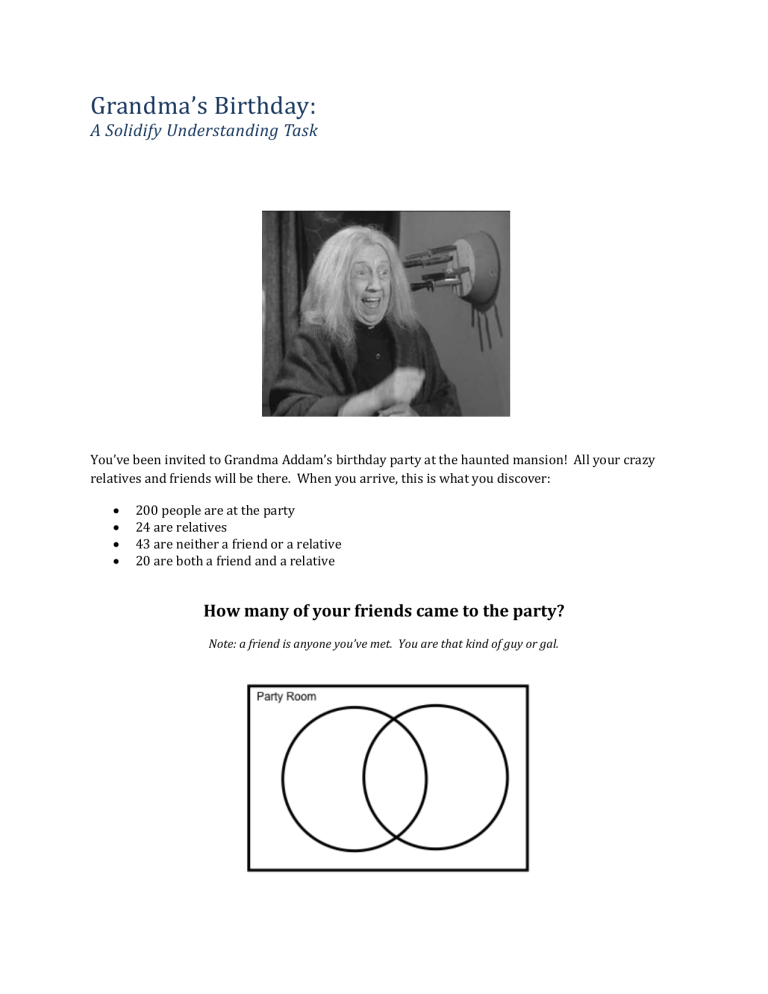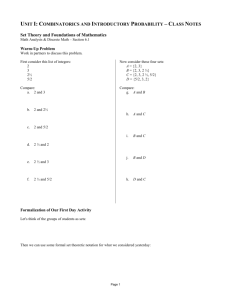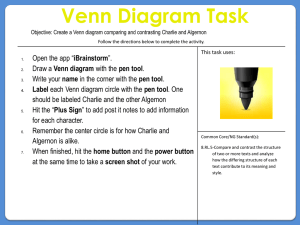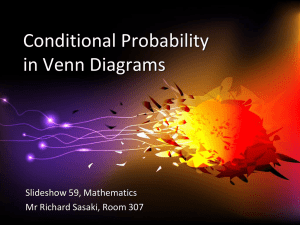Grandma`s Birthday

Grandma’s Birthday:
A Solidify Understanding Task
You’ve been invited to Grandma Addam’s birthday party at the haunted mansion! All your crazy relatives and friends will be there. When you arrive, this is what you discover:
200 people are at the party
24 are relatives
43 are neither a friend or a relative
20 are both a friend and a relative
How many of your friends came to the party?
Note: a friend is anyone you’ve met. You are that kind of guy or gal.
Once you’ve completed the Venn diagram, create a two-way table that displays the same data.
What information is more obvious from the Venn diagram?
What information is more obvious from the two-way table?
What is the probability that a randomly selected individual is a friend or a relative, that is: P(Friend or Relative).
Grandma’s Birthday: – Teacher Notes
A Solidify Understanding Task
Purpose:
Surfaces ideas such as:
● exploring the relationship between 2-way tables and Venn diagrams
● accurately representing a sample space, and accounting for each outcome
● relating spaces in a Venn diagram to the language of probability, including “and”, “or”,
“complement” and “conditional”
Core Standards Focus:
S.CP.1: Describe events as subsets of a sample space (the set of outcomes) using characteristics (or categories) of the outcomes, or as unions, intersections, or complements of other events (“or,”
“and,” “not”).
Related Standards:
Launch (Whole Class):
Grandma Addams is a character from both old TV series, movies and cartoons called “The Addams
Family”. She was a crazy old lady whose favorite hobby is wrestling alligators. No one is entirely certain whose mother Grandma is. When discussing Grandma’s living arrangements, Morticia said to Gomez
“Your mother came to visit and, apparently, never left.” In surprise Gomez replied: "I thought she was your mother!" It doesn’t matter who she belongs to, our friends and relatives are going to give her a birthday party.
Explore (Small Group):
Distribute the task sheet and allow groups time to create a Venn diagram. There are at least 4 different
Venn diagrams that can be created from the data given, dependent on which categories are chosen to be represented by the circles of the diagram. The lack of labels on the diagram is deliberate. Most will choose Friend and Relative as the labels for the circles. As the Venn diagrams are created, look for different representations.
Common errors in creating Venn diagrams relate to today’s instructional theme “How are students thinking about mathematics”. Common errors may include:
1.
Labeling the two circles Related & Not Related, then not knowing what to do about the category of Friend, and vice versa.
2.
Not subtracting the overlapping amount from both Friend and Relative. (Model norms of a math classroom by showing what can be learned from common errors.)
3.
The total number in the party room may not equal 200.
4.
When drawing Venn diagrams from scratch, students may draw the circles but forget to account for the outcomes that are not in the circles.
5.
When answering the question P(Friend or Relative) students will not know if the two sets are inclusive. In normal English usage, “or” is exclusive. In probability notation, “or” is inclusive.
Participants should finish the task sheet and the questions establishing the connections between 2-way tables and Venn diagrams.
Discuss (Whole Class):
1.
Start with displaying a participant’s representation that has inaccurate totals in the Venn diagram.
2.
Where does Grandma belong? Are “Friend” and “Relative” disjoint/mutually exclusive (no overlap, no data belongs to both sets)?
3.
Point to an area outside of the circles and ask “Who does this represent?”, then ask for proper notation. Repeat for other areas in the diagram.
Mention that there should be no attempt to draw Venn diagrams to scale. These diagrams display relationships between the data, but not the size of the data sets.
4.
In making the connection between Venn diagrams and the two-way tables, make note that there are 4 areas in the Venn diagram and there are 4 matching interior cells on the two-way tables.
Ask participants to sketch a Venn diagram directly on top of their 2-way table.
5.
Explore the questions at the bottom of the worksheet. One thing that can be seen from a two-way table is the totals. Venn diagrams help clarify relationships. Participants may have other points to bring out.
6.
Discuss the vocabulary of marginal totals and joint frequencies.
7.
Discuss abbreviations for probability areas, and notation including “and’, “or”, and
“complement”. Ask how participants can engage prior learning by relating probability notation to other set notations, including solutions to absolute value inequalities ( |x| < 5; x<5 and x>-5).
8.
What is the probability that a randomly selected person from the party is either a friend or a relative = P(Friend or Relative)?
Talk about using counts vs. percents and the advantages of each.
Find the probability of P(Friend or Relative), using the two-way table.
Generalize: illustrate P(A or B) by shading the Venn Diagram
9.
Develop the equation of the addition rule: P(A or B) = P(A) + P(B) - P(A and B) .
Support document: Sally’s Error
Mrs. Bollinger instructed her students to make a Venn Diagram representing the equation:
P(A or B) = P(A) + P(B) - P(A and B)
Sally made this diagram. Is she correct or incorrect? What was Sally thinking about as she made her diagram? Explain. (What was Sally’s error?)
10.
Disjoint/Mutually Exclusive: build a 2-way table that displays disjoint sets, and think of a context that can be represented by your table.
What does a two-way table look like for disjoint sets? (Some cells would be 0). What is the universal set for your data? What is your population?
Ask: P(A) + P(B) - P(A and B) = ????
This is the addition rule for probability. Now apply the addition rule to disjoint sets.







